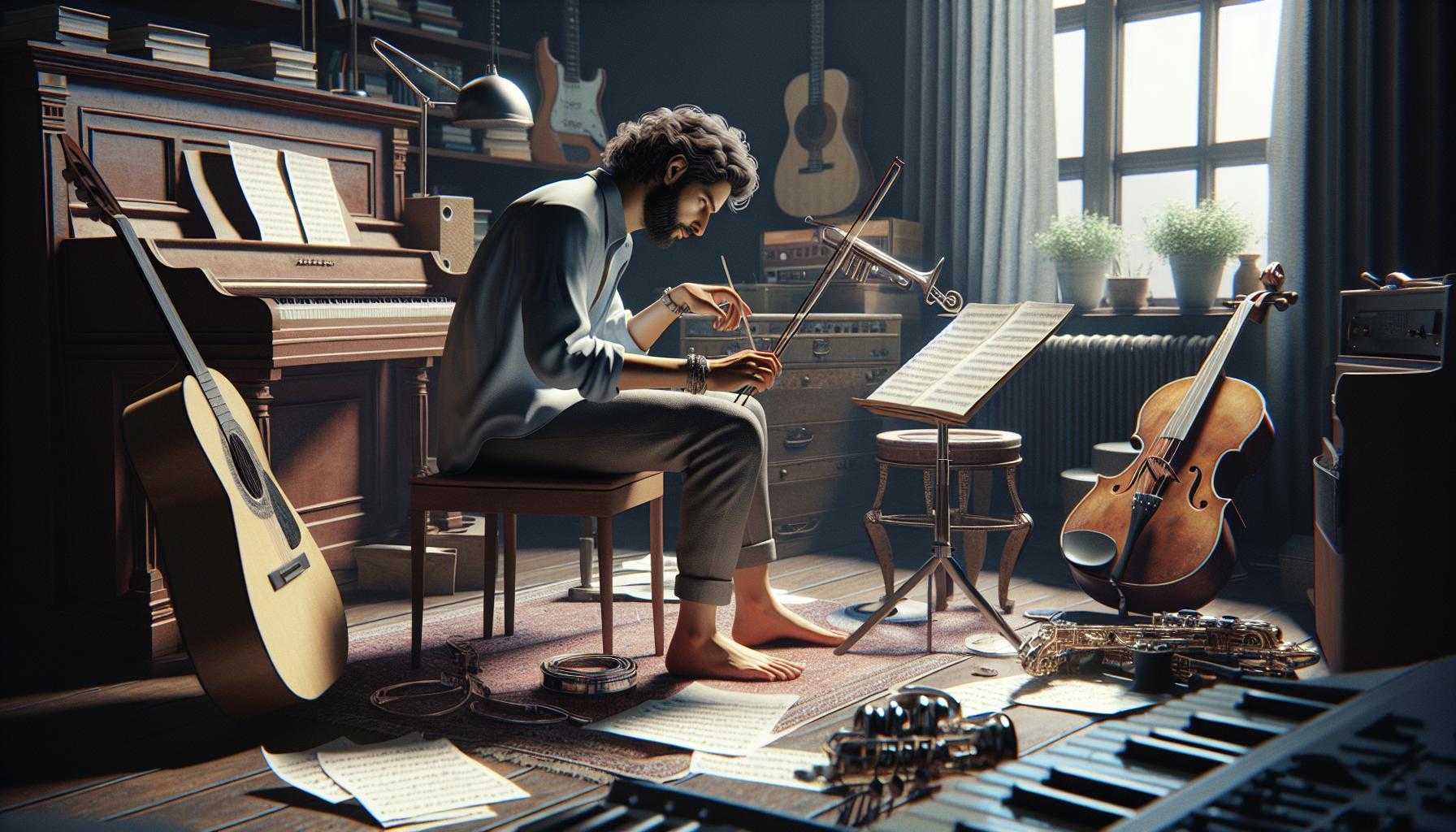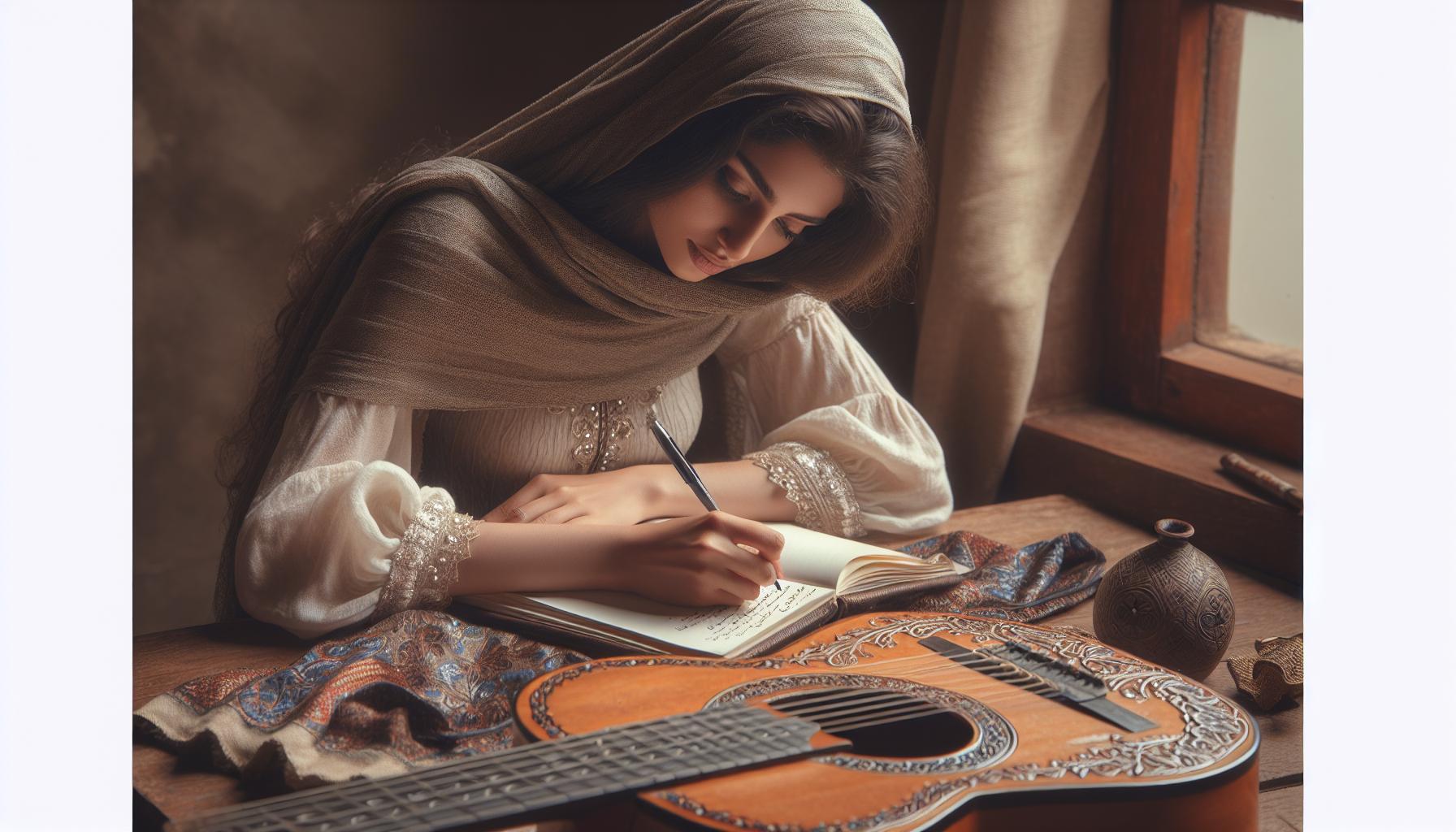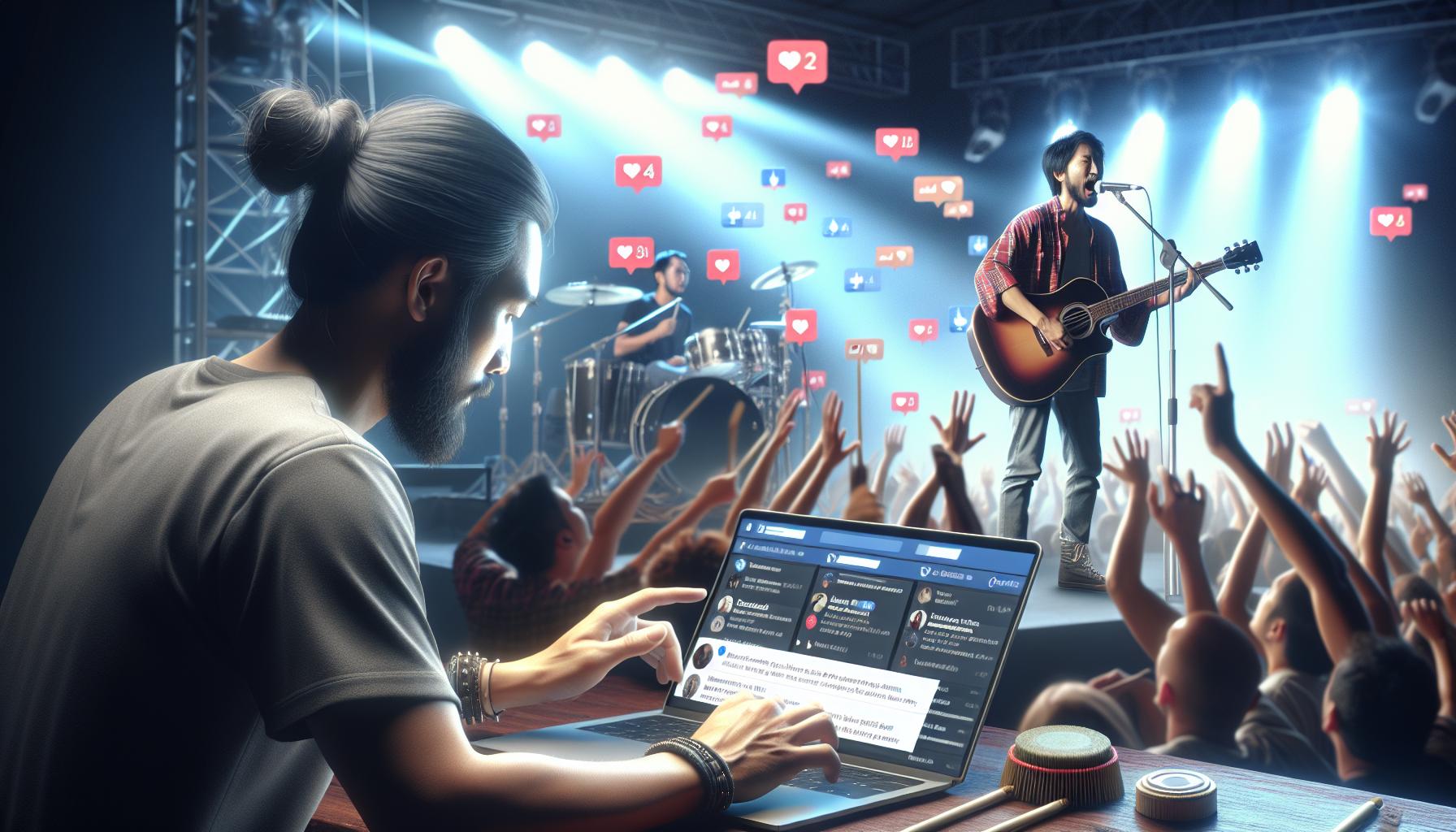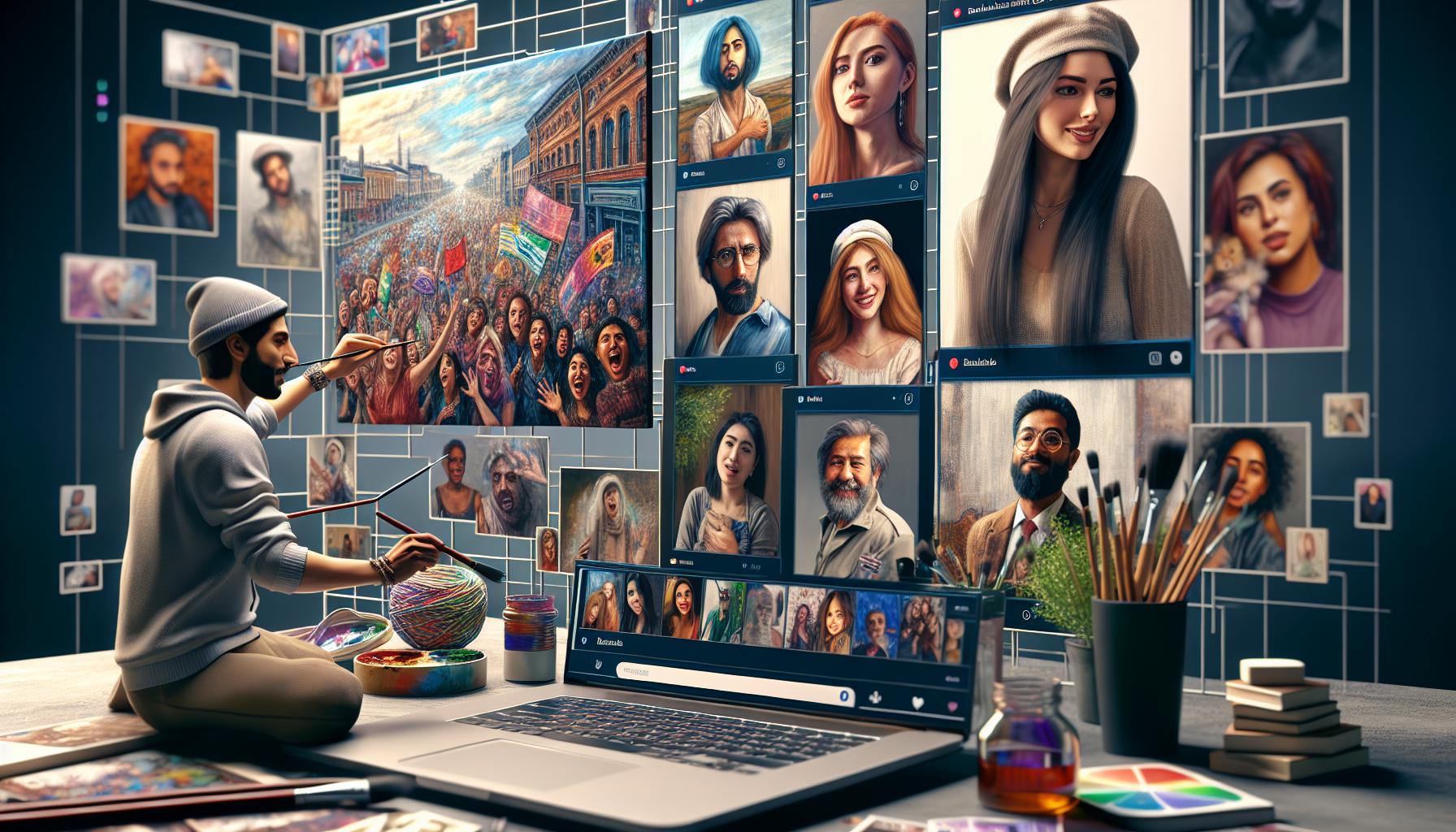In today’s hyper-competitive music industry, it’s not enough to have amazing talent. You need a strong brand that sets you apart from the crowd. That’s where artist branding comes into play.
Creating a compelling brand as a musician isn’t just about your music. It’s about your story, your style, your values, and how you connect with your audience. It’s about crafting an image that resonates with your fans and makes them feel part of your journey.
Whether you’re a budding artist or a seasoned professional, building a strong brand is crucial. It can be the difference between getting lost in the noise and becoming a household name. So let’s dive into the world of artist branding and explore how you can build a brand that truly represents you as a musician.
Contents
The Importance of Artist Branding
In today’s music industry, talent alone doesn’t cut it anymore. The marketplace is brimming with gifted artists, and each one is looking for their own spotlight. To be more than just a face in the crowd, the artist must establish a distinctive brand that is authentic, memorable, and resonates with their target audience.
Artist branding goes beyond their music; it’s about creating an enduring narrative that becomes synonymous with the artist’s work. A strong brand gives the artist a chance to share their values, style, personality, and story. This is critical because fans are drawn not only to the music but also to the meaningful connections they build with the artist.
Take for instance Madonna, an artist known for her constant reinvention. Beyond her ever-evolving music styles, Madonna has created a potent brand that thrives on her dynamism and refusal to conform. This personal touch is what brands her music, making her one of the most recognizable figures in the industry.
Branding also has a profound effect on a musician’s career from a professional standpoint. It can open doors to endorsements, sponsorships, and collaborations from companies that share the same values. Not to mention how it significantly improves visibility and recognition.
Creating an appealing, consistent brand is an ongoing task. It requires careful planning, a deep understanding of your target audience, and the ability to authentically project your personality and values. Each interaction – be it on-stage, in a music video, or on social media – is an opportunity to reinforce your brand and positively engage with your audience.
Building a strong brand is not just about outdoing your competition or selling more albums. It’s about marking your existence in the hearts and minds of your fans, creating a legacy that will outlast the fleeting hype of a breakout single.
Defining Your Brand Identity

As we delve deeper into the world of artist branding, the next essential step for any musician is defining your brand identity. This revolves around your story: who you are, the origins of your music, and why you create the art that you do. The key to an impactful brand is authenticity. Audiences can sense a phony from miles away, and they’ll respect an artist who stays true to their roots and their vision.
When crafting your identity, it’s essential to consider certain factors:
- Your unique selling points
- The image you want to portray
- Your target audience
- Your musical style
These factors should consistently reflect through your music releases, album art, social media presence, and public appearances.
For example, consider the iconic musician Madonna referenced earlier. Her brand identity is clear, audacious, and always forward-thinking. She’s built her brand around pushing boundaries, staying true to her unique style, and regularly reinventing herself to stay relevant. From her controversial music videos to her daring fashion choices, every aspect of her brand underlines these characteristics.
Being an active part in creating your brand is crucial for artists. You control the narrative and how others perceive you. Remember the role of artist branding is not just about selling records but building a lasting legacy. This implies connecting with fans, forging partnerships, attracting endorsements, and resonating with people beyond your music. Your brand identity should speak not only of your talent but also your personality and values.
Artist branding is more of a journey than a destination. You’ll continually refine and adjust your brand identity as you evolve as an artist and as a person. And no matter how successful you become, staying authentic and consistent with your brand is always key. Authenticity and relevance are two foundational elements that will guide you as you carve your path in the music industry. Regularly revisit and reassess your brand identity making sure it aligns with where you currently stand and where you aim to go.
Starting with a strong and clearly defined brand identity will set you on the right path in your musical journey. As your career develops, your brand will grow, evolve, and ultimately, become a memorable and distinct facet of your persona in the industry.
Understanding Your Target Audience

The path to successful artist branding starts with understanding your target audience. Whether you’re a blues singer or a pop icon, understanding your audience is an intuitive yet methodical process that’s central to defining your brand.
So, who exactly is your target audience? They’re the listeners who resonate strongly with your artistry – the people who will buy your albums, attend your concerts, and promote your music in their social circles. When I talk about target audience identification, knowing just age and gender is not enough. It’s essential to delve deeper and profile their demographics, values, attitudes, likes, dislikes, and even common challenges or issues they face.
Let’s consider this: you’re a hip-hop artist. Your audience is probably young, culturally diverse, and interested in contemporary social issues. Now, let’s flip the scenario. Suppose you’re a soulful country artist. Your audience might skew older, with a love for nostalgia, storytelling and soulful melodies typically associated with country music.
These different audiences not only shape the way you craft your music but also inform your overall brand persona, your promotions, the mediums used, and more. Therefore, this makes audience identification a focal point of successful artist branding.
Moreover, knowing your audience aids in creating a consistent and relatable brand image. It helps maintain and further solidify the connection your audience has with you, thereby fostering higher levels of fan loyalty.
To put things into perspective, did Madonna attract audiences by being conventional? No, she captivated by being audacious, daring, and above all, authentic. Her brand persona resonated deeply with her target audience who were drawn to her individualistic, feminine power.
Overall, getting to know your audience is an art as much as it’s science. It takes time, patience, and the willingness to listen. Recognizing and understanding your target audience is the stepping stone for a thriving career in the music industry. Dedicate time to know them and they will show up for you.
So, where should you start?
Crafting Your Brand Story

Crafting your brand story isn’t just about telling your audience who you are. Instead, it’s about creating a narrative that not only encapsulates who you are but also resonates with your audience’s experiences and aspirations. This narrative should be a reflection of your unique selling points, musical style, and desired image but it should also echo the hopes, fights, love, and lives of your fans.
The most successful music brands often have well-defined stories. For example, consider Bruce Springsteen’s branding as the everyday working man’s rockstar. He successfully created a persona that music lovers could identify with, all while staying authentic to his roots and values.
So how do you craft a compelling brand story?
Understand Your Origins
Every good story has a beginning and for an artist, that’s typically their roots. Your origins, struggles, victories, and inspirations play an integral role in defining who you are as an artist. And these elements can greatly shape your brand story.
Whether it’s the childhood thrill of hearing a classic rock song for the first time or the emotional rollercoaster that inspired your hit album, these experiences are a crucial part of your story. Reveal these glimpses into your life to help your audience understand why you do what you do.
Be Authentic and Consistent
Remember, authenticity isn’t just important. It’s vital. A crafted story that doesn’t reflect the true identity of the artist will quickly unravel and potentially damage their reputation. Therefore, maintain consistency across all platforms and media in your messages, music, style, and actions to reinforce your brand image.
In crafting your brand story, emphasize the truth behind your music. Remember that this isn’t about creating a fictional narrative but discovering and sharing the real narrative that’s already existent in you and your music. Every song, album, and art you create is a chapter in your story.
Creating a Consistent Visual Identity

Visual identity is a vital component in artist branding. It’s not just about the music, and I can’t stress this point enough. It encompasses everything from logo designs, album covers, to your style and even your Instagram feed. Each of these visual elements offers an opportunity to convey your brand’s unique personality in a powerful and unforgettable way.
An excellently designed logo, for example, often triggers an immediate association with the brand it represents. Think of the renowned ‘tongue and lips’ logo of the Rolling Stones. It’s compelling, iconic, and immediately recognizable. No wonder it’s the emblem people connect with their rebellious and audacious brand image.
It’s equally essential to ensure consistency across all your visibility platforms. The fonts, colors, stylized images on your website should align with the visuals on your social media pages or album covers. A discrepancy in these visual displays can dilute the strength of your brand, causing confusion among your audience, and possibly, a disconnection. Remember, your goal is to seep into your audience’s subconscious through repeated and consistent imagery. Inconsistency, in contrast, can break that connection.
Uniformity in your visual imagery also aids in reinforcing your brand story. Every artist has a unique story to tell, and when your visual elements reflect and reinforce this narrative, it adds depth to your brand.
Strong visual branding needs a strategic, systemic, and continuous approach. It’s not a one-time task, but a practice that evolves with the progression of your music and personal growth. As you develop and grow as an artist, so should your visual identity.
So, when you’re deciding on a logo, selecting promotional photos, or revamping your website, consider how each of these elements fits into your broader brand narrative. It’s about creating a visual identity that personifies who you are as an artist, communicates your story, and resonates with your audience. That’s what sets successful brands apart. Now, let’s dive into the nitty-gritty of defining your brand’s visual identity.
Building Your Online Presence
In the digital age, one cannot underestimate the role of a musician’s online presence. It’s the railroad to your brand, fostering a deeper connection with your audience and widening your reach. Realize that your online presence is an extension of your brand. Everything from your social media profiles to your website should uniformly present your brand.
First up, social media platforms. It’s the best place to engage your fans directly, create buzz around your music, and keep them updated on your upcoming projects. Sites like Instagram, Twitter, and Facebook offer great avenues to show your brand’s human side. You’ve got to be active, responsive, and visible. Essentially, your posts should reflect your brand identity and musical style. Do not forget your profile photos, cover images, and bio should be consistent with your brand. Social media is also a fantastic opportunity to share your brand story and highlight how it is evolving over time.
Next, consider your website. Think of it as your digital headquarters where the audience can have an all-round experience of your brand and music. It’s where your music, videos, photos, tour dates, and blogs live. Make sure the design and content of the webpages align with your brand persona. Highlight elements that make you unique and different from others. Keep it simple, organized, and easy for visitors to navigate.
In addition, email newsletters make for a more personal interaction. Let your fans feel like they are part of your journey. Share insights about your projects, behind-the-scenes stuff, and maybe a sneak-peek into your creative process. Let them know about your latest releases and upcoming events first. Keep the design of your newsletters consistent with your brand aesthetic.
Remember, a successful online presence isn’t built overnight. It requires consistent effort, time, and strategic planning. Balance between being promotional and offering valuable or entertaining content. Regularly assess your online presence to see if it’s in line with your brand identity and adjust as needed.
We’ve discussed the importance of an online presence. Let’s veer towards understanding how to tailor your messages appropriately – the subject of the next section. Professionalism in your interactions and staying true to your chosen brand personality is the key.
Engaging with Your Fanbase

One factor that strengthens the bridge between an artist and their audience is continual engagement. Building this connection isn’t a one-time event – it’s an ongoing task and key to establishing a lasting bond with fans. Effective engagement can lead to an increase in fan loyalty, setting an artist apart in the crowded market of the music industry.
Social media is the platform of choice when it comes to connecting with fans. Artist-fan communication has radically changed with the advent of these channels. Before the rise of social media, fan engagement was largely one-sided – fans received information, but there was seldom a direct line of communication with the artist. Now, every post, direct message, reply, and story forms an opportunity to build a stronger relationship with your fanbase.
Using Instagram, Facebook, Twitter, YouTube, and other platforms doesn’t just equate to “presence” but provides a powerful tool that gives multi-directional access to your fans. However, keep in mind that simply being on these platforms isn’t enough. You must be active and visible.
Regularly updating your profiles with engaging and relevant content enhances your brand’s accessibility. Let’s not forget the importance of comments and direct messages – these spaces prove vital in maintaining connections with fans on a closer, more intimate level. Always make sure to respond to comments and messages as much as possible, showing appreciation, acknowledging fans’ support and keeping the dialogue going.
Being on social media also presents a golden opportunity to give fans an exclusive peek behind the curtain. Share sneak peeks of upcoming projects, post studio updates, or live videos. These insights into your world as an artist create excitement and anticipation.
However, the digital world is not the only place to connect with your fans. Don’t overlook the power of live shows and meet & greets. These face-to-face interactions often lead to lifelong fans, as they present a valuable chance to form real, tangible connections.
Having said all that, effective fan engagement isn’t just about being active on social media or hosting events. It’s about a strategic approach that values interaction and places fans at its core. After all, your fanbase is the heartbeat of your brand. It’s them who you’re doing all this for and it’s their support that will help steer your brand towards success. These communications create stronger bonds, but they also emphasize the main message of your brand and ultimately end up shaping your identity as an artist.
Leveraging Social Media for Brand Promotion

The world of social media is a gold mine for musicians looking to build and solidify their brands. From Instagram to YouTube and Twitter, each platform has its unique advantages for artists.
Instagram is a fantastic place to visually express your brand. As an artist, your imagery, personal style, and thematic elements of your music can all shine through in the photos and videos you share. You can even utilize the Instagram Stories feature for behind-the-scenes content or casual interactions with fans, enhancing their sense of connection to your brand.
On YouTube, you have opportunities to promote your music directly, through music videos, lyric videos, or behind-the-scenes footage. YouTube also allows for more in-depth content, like interviews or documentary-style videos that can tell your story and give a deeper understanding of you as an artist.
Twitter, on the other hand, is a real-time communication tool where you can interact with your audience through tweets and replies. It works best for short, engaging updates on daily life and ongoing projects and can be surprisingly effective in terms of generating back-and-forth interactions with your fanbase.
Across all these platforms, it’s vital that all the content you post aligns with your brand’s identity. Your social media presence is an extension of your brand, and any discrepancy can lead to confusion among your followers.
Operating social media may seem overwhelming, but it’s manageable with planning and consistency. Creating a content calendar can help in scheduling posts and maintaining consistent engagement. Also, remember that while striving for professionalism, it’s crucial not to lose authenticity. Your followers are there to connect with you personally, not a manufactured image.
Moving forward, let’s delve into more specific strategies to engage with your audience and build your brand through social media…
Collaborating with Other Artists

Expanding your brand in the music industry means reaching out beyond your comfort zone and collaborating with other artists. Think of collaboration as a mutual promotion opportunity. You’re not just gaining exposure from your fan base but also tapping into another artist’s audience.
This isn’t just about expanding your reach though. When you connect with other creators who align with your brand values, you build relationships that can fuel your creative journey. It reinforces your brand and allows you to explore new creative avenues that may not have been possible on your own.
As you start your collaboration journey, it’s helpful to remember:
- Approach artists who complement your brand
- Maintain authenticity throughout the process
- Ensure the collaboration benefits both parties
When the time comes for my own collaborations, I’ve found it’s best to approach artists that can complement my brand. If your brand is about empowering youth, linking up with an artist who shares that mission can create a powerful message.
Authenticity is key in all aspects of your brand, and collaborations are no different. Any joint venture has to feel authentic to your audience, so finding artists who naturally align with your brand values is crucial. A daring collaborative piece may surprise your fanbase, but if it doesn’t resonate with your brand, it could confuse them instead.
Finally, ensure the collaboration is mutually beneficial. This isn’t just about boosting numbers. It’s about creating a valuable and lasting relationship. The collaborations you choose should enrich your brand, enhance your art, and introduce you to new audiences.
In the end, collaborations are about challenging your creativity, nurturing your brand, and connecting with a wider audience. As your brand grows, so will your opportunities for exciting and meaningful collaborations. Continue learning, continue growing and above all, stay true to your brand and your art.
Expanding Your Brand Beyond Music
As an artist performing and creating music is essential but it’s also vital to expand your brand beyond the music. Engaging with other forms of media can broaden your reach and strengthen your brand.
Think about movies and TV shows. Many successful artists have made appearances on popular programs or had their music featured in films. Weekly television programs reach millions of viewers who may not be aware of your music. By integrating music into other forms of media new audiences can be introduced to your brand. This cross-promotion can increase your visibility both on and off the stage.
The same applies to other platforms such as YouTube podcasts and radio shows. Keep yourself open to all opportunities.
Take the example of numerous major pop stars who have guest-hosted major events such as award shows. Not only does this opportunity allow them to show another side of their personality but it also acts as a promotional platform reaching a vast audience. Essentially getting an invite to guest host means you’re being recognized at a level that boosts your brand profile.
This is not to say that every artist should start acting or hosting. Remember consistency is key. You must find ways that fit within your brand identity. Engage in activities that feel natural and authentic to you and your audience. Don’t pursue an action simply because it worked for someone else. Your initiatives should resonate with your personal brand story and your fan base.
Try and collaborate in a way that opens up opportunities. This could be making merchandise featuring your distinctive visual identity creating a signature fragrance or designing a clothing line. Many artists have tapped into these markets to connect with their fans on a deeper level.
Madonna for instance has launched a range of products from clothes to perfumes.
The key takeaway here is to consider expanding your brand beyond just your music. Diversify your brand whilst maintaining the essence of who you are as an artist. After all it’s you that your fans connect with.
Conclusion
Building a strong brand as a musician isn’t just about creating great music. It’s about carving out a unique identity, connecting with your audience, and diversifying your brand beyond music. It’s about consistency in your visuals and a robust online presence. Take a page from Madonna’s book – be distinctive and authentic. Understand your audience and craft a compelling brand story that resonates with them. Don’t shy away from exploring other media forms like movies, TV shows, and podcasts. Consider opportunities to broaden your reach, whether that’s guest-hosting events or launching a line of merchandise. Remember, diversification is key, but authenticity is king. Striking the right balance between the two is what makes an artist’s brand truly powerful.
